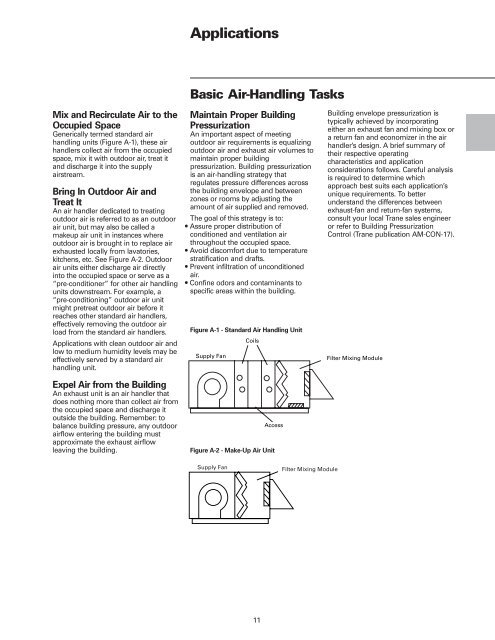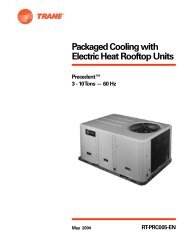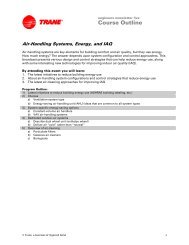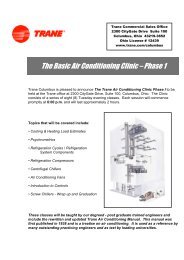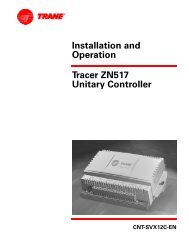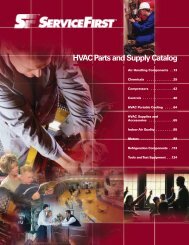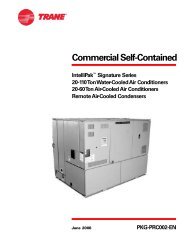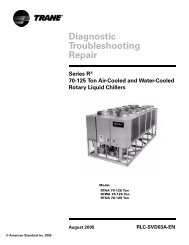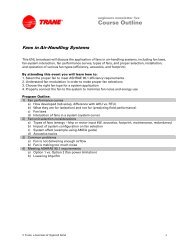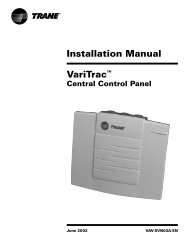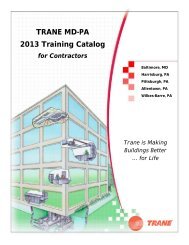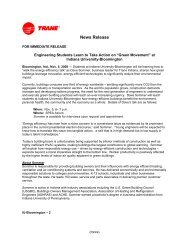T-Series Climate Changer ® Air Handlers Sizes 3 through ... - Trane
T-Series Climate Changer ® Air Handlers Sizes 3 through ... - Trane
T-Series Climate Changer ® Air Handlers Sizes 3 through ... - Trane
You also want an ePaper? Increase the reach of your titles
YUMPU automatically turns print PDFs into web optimized ePapers that Google loves.
Mix and Recirculate <strong>Air</strong> to the<br />
Occupied Space<br />
Generically termed standard air<br />
handling units (Figure A-1), these air<br />
handlers collect air from the occupied<br />
space, mix it with outdoor air, treat it<br />
and discharge it into the supply<br />
airstream.<br />
Bring In Outdoor <strong>Air</strong> and<br />
Treat It<br />
An air handler dedicated to treating<br />
outdoor air is referred to as an outdoor<br />
air unit, but may also be called a<br />
makeup air unit in instances where<br />
outdoor air is brought in to replace air<br />
exhausted locally from lavatories,<br />
kitchens, etc. See Figure A-2. Outdoor<br />
air units either discharge air directly<br />
into the occupied space or serve as a<br />
“pre-conditioner” for other air handling<br />
units downstream. For example, a<br />
“pre-conditioning” outdoor air unit<br />
might pretreat outdoor air before it<br />
reaches other standard air handlers,<br />
effectively removing the outdoor air<br />
load from the standard air handlers.<br />
Applications with clean outdoor air and<br />
low to medium humidity levels may be<br />
effectively served by a standard air<br />
handling unit.<br />
Expel <strong>Air</strong> from the Building<br />
An exhaust unit is an air handler that<br />
does nothing more than collect air from<br />
the occupied space and discharge it<br />
outside the building. Remember: to<br />
balance building pressure, any outdoor<br />
airflow entering the building must<br />
approximate the exhaust airflow<br />
leaving the building.<br />
Applications<br />
Basic <strong>Air</strong>-Handling Tasks<br />
Maintain Proper Building<br />
Pressurization<br />
An important aspect of meeting<br />
outdoor air requirements is equalizing<br />
outdoor air and exhaust air volumes to<br />
maintain proper building<br />
pressurization. Building pressurization<br />
is an air-handling strategy that<br />
regulates pressure differences across<br />
the building envelope and between<br />
zones or rooms by adjusting the<br />
amount of air supplied and removed.<br />
The goal of this strategy is to:<br />
• Assure proper distribution of<br />
conditioned and ventilation air<br />
<strong>through</strong>out the occupied space.<br />
• Avoid discomfort due to temperature<br />
stratification and drafts.<br />
• Prevent infiltration of unconditioned<br />
air.<br />
• Confine odors and contaminants to<br />
specific areas within the building.<br />
Figure A-1 - Standard <strong>Air</strong> Handling Unit<br />
Figure A-2 - Make-Up <strong>Air</strong> Unit<br />
11<br />
Building envelope pressurization is<br />
typically achieved by incorporating<br />
either an exhaust fan and mixing box or<br />
a return fan and economizer in the air<br />
handler’s design. A brief summary of<br />
their respective operating<br />
characteristics and application<br />
considerations follows. Careful analysis<br />
is required to determine which<br />
approach best suits each application’s<br />
unique requirements. To better<br />
understand the differences between<br />
exhaust-fan and return-fan systems,<br />
consult your local <strong>Trane</strong> sales engineer<br />
or refer to Building Pressurization<br />
Control (<strong>Trane</strong> publication AM-CON-17).


